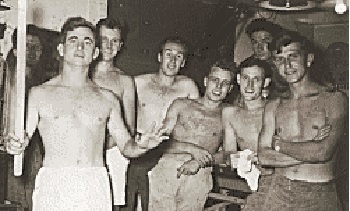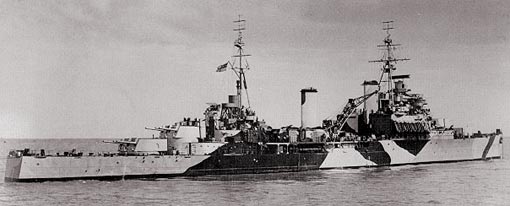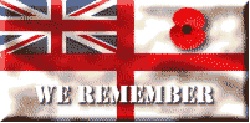
H.M.S. Jamaica -Korean War Service 1950
 |
H.M.S. Jamaica -Korean War Service 1950
By John Hegarty. Lieutenant Commander RN
Rtd
|
| Precisely 50 years ago I was serving on board the
Cruiser HMS Jamaica in Korea !. Now, in the new Millennium it is indeed
appropriate to recall those far off days and remember our shipmates and
others who did not return. In 1949, I had been a Radar Plot Instructor at
the RP School , HMS HARRIER in West Wales. It was a good job and
with a fair complement of WRNS at the base, life was good. Certainly, I
had no inkling of any "draft" coming my way for some time to come.
We had read of HMS Amethyst and the Yangtse incident with admiration
but, that was far away, and my priorities did not include thoughts of
the Far East. So it came as something of a surprise when I was
informed of my posting to HMS JAMAICA once I had taken draft leave in
the UK. JAMAICA had been stationed in the West Indies, considered
by most to be a rather "cushy number", so of course I was not the only
one "crying in my beer" when the ship was moved to the Far East Station
as a result of the tension and uncertainty in that area. JAMAICA was to
replace HMS LONDON, which had suffered considerable damage during the
Yangtse affair. There followed some hectic domestic arrangements
that included such minor matters as getting married to Bernice, my WRNS
fiancée, with a short honeymoon in a wet and stormy south coast town.
I joined HMS OCEAN at Devonport for the month long passage to Hong Kong
where I joined HMS JAMAICA. It was November 1949. I soon settled in and my main duties were
Coxswain of the Ships Motor Boat and at sea in charge of one watch of
the Action Information Organisation under the ships Direction Officer,
Lieutenant Tim Fetherson-Dilke.RN JAMAICA was commanded by Captain J. S. C. Salter,
DSO, OBE (who succeeded Capt. F. A. Ballance RN in 1950) and the Flag
Officer 5th Cruiser Squadron was Rear Admiral W. G. Andrews, CB, CBE,
and DSO, flying his flag in HMS BELFAST
Whilst in Hong Kong we had cultivated a friendly
relationship with the local army garrison and as part of this liaison a
party of NCOs had been invited on board for the trip to Japan. It
was considered a recreational break from their duties in the New
Territories, where the "Bamboo Curtain" separated the Colony from
Communist China. It comprised men from the Middlesex
Regiment and the Royal Artillery. Accordingly, in early June, JAMAICA sailed from
Hong Kong for Japanese waters on what was planned to be a normal
deployment. Whilst on passage we heard the news of a North Korean
attack on South Korea. At first it was assumed this incursion was
another example of the "sabre rattling" which frequently occurred on the
Korean Peninsular and it would come to little. Within a short time it
became apparent this was a major invasion that could change the fragile
balance of power between China, Russia and the West. The U.N. Security
Council met in urgent session and as they say, the rest is history!
The "KOREAN WAR" began |
|
Within hours JAMAICA and BLACK SWAN were
despatched to the east coast of Korea to join USS JUNEAU. Our task was
to attack advancing Communist troops as they piled south along the coast
road. This took our small force to the very border of the 38th
Parallel. As we progressed north to the designated area of
operations we saw the first signs of the savagery of what was to come.
The sea was calm and we encountered large numbers of floating corpses
tied together in pairs. The stench was sickening even from the
ship doing about 15 knots through the water. Once in our
target area we commenced bombarding the coastal targets, troops,
transport, roads, bridges, rail tracks etc. In fact anything of possible
use to communist forces was attacked. It was at dawn on July 2nd, the ship was at
action stations, and I was in the bridge plot room. Despite having
our radar operating, we were surprised to hear the report broadcast from
the bridge that a visual sighting of fast moving surface craft were
heading towards our unit. This proved to be six Motor Torpedo/E
Boats, which had approached down the coast out of radar cover. Turning
towards Jamaica and Black Swan their speed increased and though
hypnotically impressive, they posed a very real threat indeed. "Alarm
Surface Port" I heard the tannoy broadcast. Then followed the
well-rehearsed series of orders and responses as the various control
stations and guns crews leapt into action.
"Engage" - "Shoot" - "Fire"! I was used to the drill, but hell,
this was for real! The guns fired, at first with one main salvo that
shook the ship to its keel, then the subsequent salvoes that were more
sporadic but none the less equally deadly. My plotting team tried to
concentrate as we scanned the radar for targets further away. It was
vital not to lose control of the overall situation but thankfully the
displays were void of any unidentified moving targets. |
 |
|
The visual reports from the bridge continued to
come through; "Target stopped", "Possible Hit", "Fire and smoke
visible", "Target sinking", and still the guns continued to fire.
Then silence as "Guns" gave the order to cease firing. The
result, five out of six enemy craft destroyed and one MTB grounded
ashore and abandoned by the crew. It was an easy matter to
direct a few well-aimed rounds to ensure she would not be of further use
to the North Koreans. This proved to be the first action by UN Ships in
what was to be a long and bitter war. It was a resounding success
for our small force but it emphasised the fact that the North Korean
threat was very real. We continued our task of bombarding the coast
road and railway close to YangYang. Our routine was to shell the
high points of land, overhanging the railway lines and roads, by day
bringing down as much debris as possible to block the passage of
military convoys. These convoys travelled by night to avoid attack, but
when they came across these obstacles, they had to clear the roads
manually. This involved the use of lights by the army units
and provided an ideal target for JAMAICA and her small force waiting,
darkened, within gun range of the coast. Occasionally, in the silence of
a calm sea, we could hear the shouts and commands of the soldiers ashore
as they struggled to clear the debris. The ensuing disruption of
supplies to the Communists was substantial and from the ship, lying so
close offshore, the ammunition and fuel exploding as a result of our
gunnery was awesome. |
|
Inevitably, North Korean Forces were sure to take
some action to counter our activities. Artillery was moved to defend the
road and rail system. On July 8th while JAMAICA, with JUNEAU and
BLACK SWAN in company, were bombarding targets on the coastline, the
ships came under fire from these shore batteries. JAMAICA took a direct
hit near the base of the mainmast and close to a gun mounting.
Sadly, six men were killed. These were the first casualties of the war
at sea in the Korean conflict. Of the dead, five were soldiers of the
Middlesex Regiment and the Royal Artillery who had come on board at Hong
Kong for what was to be a "sea cruise". They had volunteered to
act as ammunition numbers at various gun-mountings when required. One
seaman was killed and five others were wounded. The ship did not suffer
serious material damage but I recall when viewing the carnage from the
bridge, our "Battle Ensign" had been blown away by the blast. Shortly after, the bodies of those killed were
buried at sea with full military honours, with the service being taken
by The Reverend. Raymond Lowe R.N., the ships' Padre. A sad and
sombre occasion. To this day I can vividly recall the six splashes as
the dead were committed to the deep. JAMAICA continued operations on the east coast of
Korea and U.S and U.K units were soon joined by ships from Australia,
New Zealand and other Commonwealth countries. European
countries also took part and ultimately produced the largest
international naval force since WW2. Sasebo in Japan was the main base for logistics
and the limited shore leave allowed. It was a small port with little to
offer ashore. US facilities included a club but RN personnel were
restricted by the draconian fiscal rules prevailing at that time which
did not allow UK personnel to exchange sterling for US dollars. The
picture on the left shows Chats Harris and myself shopping at the local
branch of M & S in Sasebo." The next phase for JAMAICA was to switch
operations to the west coast of Korea and ultimately to the Inchon
landings. Immediately before September 1950 the North Korean
forces, supported by the Red Chinese Army, had forced UN land forces
back to a perimeter around the port of Pusan. It was a desperate
situation and required a bold initiative to release this stranglehold.
General MacArthur decided to take such an initiative with an amphibious
landing at the port of Inchon. It was a difficult task but if
successful would outflank North Korean forces at a stroke and could
change the course of the whole campaign. |
 H.M.S JAMAICA |
|
The Inchon operation would take many pages to
describe, but suffice to say JAMAICA participated in the bombardment
before the landing and covered the operation throughout. However, one
daring action, prior to the affair, remains in my memory. The evening before the landing, four U.S
destroyers sailed up to the port of Inchon in confined waters with no
cover and little room to manoeuvre; their purpose was to draw enemy fire
in order that an assessment could be made of likely resistance when the
landing craft went in next day. They proceeded in formation, flags
flying, and guns manned. The inevitable response came from
the defences ashore as the ships drew fire from the shore batteries.
It seemed like an age to those of us awaiting their return, but
eventually all four reappeared, still in proud formation, but perhaps
their upper works not quite so shipshape as before. We learnt
subsequently one of the destroyer's C.O. had been killed and many
others too, but the likely strength of resistance was assessed and it
surely went a long way in ensuring a successful assault next day. The day following the landing, together with
other ships, JAMAICA was at anchor in the approaches to Inchon.
Nearby was the HQ ship, USS Mt. McKINLEY, with General Douglas MacArthur
on board. All appeared to have gone well ashore, but nevertheless,
in accordance with usual RN practice, the ship went to dawn action
stations as the first signs of light appeared on the horizon. From long
experience over war years, this was the time of maximum threat from
attack. Being landlocked, our radars were not effective. Just as
it got light, over the tannoy system came the report, "Alarm Aircraft
Starboard" and then followed the usual commands for the guns to stand
to. An aircraft was sighted and was reported over the
broadcast system. Those of us below decks could understand what was
happening. We heard the thump of two explosions and the broadcast
reported "two bombs had been dropped astern of the Mt. McKinley". |
|
Again the broadcast - "Aircraft turning towards". Immediately those guns sighted were trained on the approaching aircraft. There was a desperate urgency throughout the ship to hear our guns respond - but the Captain, calmly but with complete assurance, ordered the guns not to fire but to track the target as it closed the ship. Then, when near enough to read the insignia on its fuselage, the order came - "Fire". JAMAICA shook from stem to stern as every gun free to engage fired and the unfortunate pilot together with his aircraft disintegrated in a flash and disappeared into the water. A second aircraft was sighted and again engaged, this time it veered away from us as it saw the first aircraft explode, but the guns were successful and although not quite so dramatic the aircraft was last seen losing height and subsequently crashed as it crossed the estuary. Later reports indicated the aircraft had strafed the ship causing some casualties and one sailor, Boy Seaman Ron Godsall was fatally wounded.
|
|
 |
The picture on the left was taken after the
landings at Inchon when we took some personnel from the ship to the main
jetty inside Inchon Harbour. The party included several press reporters,
one I remember was the "Daily Express" correspondent. We also landed
Father Briscoe, the Fleet R.C.Padre, who was to stay ashore with shore
forces. Picture shows from left, AB Maguire, Midshipman and myself
(with gun). |
|
JAMAICA
remained in Korean waters for several more months ultimately returning
to Hong Kong for maintenance. There, it was discovered that
the ship required extensive mechanical repairs to her engines and it was
decided this could best be completed at an UK Dockyard. Some of the
ship's company were allocated to other ships before we finally left for
the UK, so it was not quite the end of the Korean "adventure" for them. Fortunately, I remained on board and returned to England with the ship. When we arrived at our homeport of Plymouth the ship had an ecstatic welcome especially as we were the first major warship to return from the Korean War.
|
|
 |
I
am grateful to the team at the website "Britains Small Wars" for
including this account in their pages.
J.D.Hegarty. https://web.archive.org/web/20101213121922/http://britains-smallwars.com/korea/Jamaica2.htm |
 |
Sergeant Bernard Finch. |
This article has been reproduced entirely from the original for ease of connecting to the Ralph Barwick story
Alan Swain -February 2021